I’ve spent way too much time staring at rugs that just didn’t work: too small, awkwardly placed, or making my furniture look like it was floating in space.
If you’ve ever wondered why your room feels “off” even after decorating, the rug size might be the culprit.
Getting rug sizes right isn’t just about measurements; it’s about creating balance and making your space feel intentional.
From living room layouts to dining room setups, I’ll share what I’ve learned about standard rug sizes, placement tricks, and common mistakes to avoid, so you can finally find a rug that pulls everything together.
Standard Rug Sizes Explained
Rug sizes guide showing common dimensions, clear explanations, and practical charts to help you choose correctly for every room.
1. Small Rugs (2×3, 3×5): Entryways, Bathrooms, Accent Use
Small rugs provide a quick way to add comfort and style to compact areas. A 2×3 rug is often placed in front of sinks or doorways, while a 3×5 rug fits entryways, bathrooms, or small reading corners.
These rugs highlight furniture groupings without overpowering the space. They’re also portable, making them easy to swap or layer.
For renters or apartment living, small rugs can help define areas affordably while still giving a cozy surface underfoot.
2. Medium Rugs (4×6, 5×7, 6×9): Apartments, Smaller Living Rooms
Medium rugs are the most versatile option for apartments, condos, and small family rooms. A 4×6 rug fits beneath a coffee table, while 5×7 or 6×9 sizes work well for defining seating arrangements without crowding the layout.
They also suit smaller dining tables or bedrooms with full and twin beds. These rugs give you flexibility in furniture placement while leaving visible flooring around the edges.
Medium rugs are the sweet spot between functional coverage and preserving open floor space.
3. Large Rugs (8×10, 9×12, 10×14): Living rooms, Dining Rooms, Bedrooms
Large rugs are standard picks for main gathering rooms. An 8×10 rug anchors furniture in medium living rooms, while a 9×12 rug covers most furniture legs in larger layouts.
For dining rooms, these sizes allow chairs to remain on the rug even when pulled out. Bedrooms with queen or king beds also benefit from large rugs placed beneath the frame and nightstands.
These dimensions make furniture groupings feel intentional and balanced, avoiding the common mistake of rugs that look undersized.
4. Extra-Large Rugs (12×15, 12×18): Open-Concept Spaces
Extra-large rugs are best for spacious layouts and open-concept homes. A 12×15 or 12×18 rug unifies multiple seating zones in one area, such as a living room combined with a dining nook.
These oversized pieces create cohesion in rooms where smaller rugs would fragment the layout. These oversized pieces create cohesion in rooms where smaller rugs would fragment the layout.
When used outdoors on patios or decks, extra-large rugs can frame large furniture sets, creating distinct yet seamless areas for entertaining or lounging.
Cheat Sheet: Room Size vs. Rug Size
| Room Type | Common Furniture Setup | Recommended Rug Sizes | Material Tips |
|---|---|---|---|
| Small Entry/Bath | Sink, door, or small bench | 2×3, 3×5 | Washable cotton or synthetic |
| Small Living Room | Sofa + coffee table | 4×6, 5×7, 6×9 | Flatweave or low pile |
| Medium Living Room | Sofa + chairs | 8×10 | Medium-pile wool blend |
| Large Living Room | Sectional + chairs | 9×12, 10×14 | Medium pile with rug pad |
| King Bedroom | Bed + nightstands | 9×12, 10×14 | Medium-pile wool or synthetic |
| Queen Bedroom | Bed + nightstands | 8×10 | Medium pile, washable |
| Dining for 4 | Small table + chairs | 6×9 or 4–6 ft round | Low pile for easy chair movement |
| Dining for 6 | Medium table + chairs | 8×10 | Low pile for easy chair movement |
| Dining for 8–10 | Large table + chairs | 9×12 or 10×14 | Low pile, durable |
| Outdoor Patio | Lounge or dining set | 5×7, 6×9, 8×10+ | Quick-dry polypropylene |
How to Choose the Right Rug Size?
Choosing the right rug size starts with measuring your room and furniture layout. For living rooms, rugs should cover about 60–75% of the room’s width and length or extend 8–12 inches beyond furniture edges.
In dining areas, add 24–30 inches on all sides of the table so chairs stay on the rug when pulled out. For bedrooms, extend the rug 18–24 inches past the bed frame for walking space.
Examples:
- Living Room: A 12×16 ft room × 70% coverage ≈ 8×11 ft, so an 8×10 or 9×12 rug fits best.
- Dining Room: A 3×6 ft table + 24 in clearance on all sides = about an 8×10 ft rug.
- Queen Bed: Bed size 5×6.5 ft + 24 in extension around = roughly 8×10 ft rug.
Always check door clearance and traffic flow. When uncertain, size up; larger rugs create balance, warmth, and visual harmony.
Living Room Rug Size Guide
Living room rugs should define seating zones and balance furniture. Correct sizing avoids floating pieces and creates a comfortable, connected gathering area for conversation or entertainment.
1. All Legs on Rug

Placing all furniture legs on the rug creates a unified, anchored look. It works best with larger rugs like 9×12 or 10×14, ensuring sofas, chairs, and tables sit entirely on the surface.
This option makes big rooms feel balanced and polished, while keeping conversation zones visually tied together. Measure carefully so edges leave equal floor space for symmetry.
2. Front Legs Only

Front legs on the rug create a connection without needing oversized rugs. This flexible option works well in medium-sized living rooms, balancing comfort with open floor space.
A coffee table rests fully on the rug, grounding the room visually while preserving flexibility.
3. Floating Rug Under Coffee Table
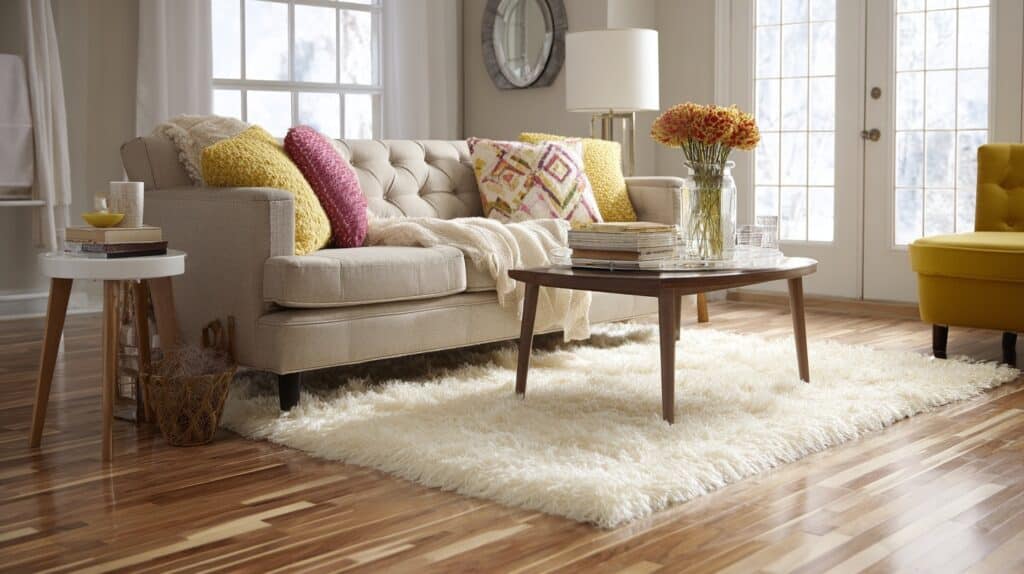
A floating rug under only the coffee table suits smaller living areas or apartments. Typically using 4×6 or 5×7 rugs, this approach highlights the center of the room without covering every piece.
It provides a stylish accent while showing more flooring, which is useful in compact layouts. Although not as unified as larger rugs, it offers a budget-friendly solution.
4. Sectionals and Chaise Sofas: Rug Sizing for L- and U-Shapes
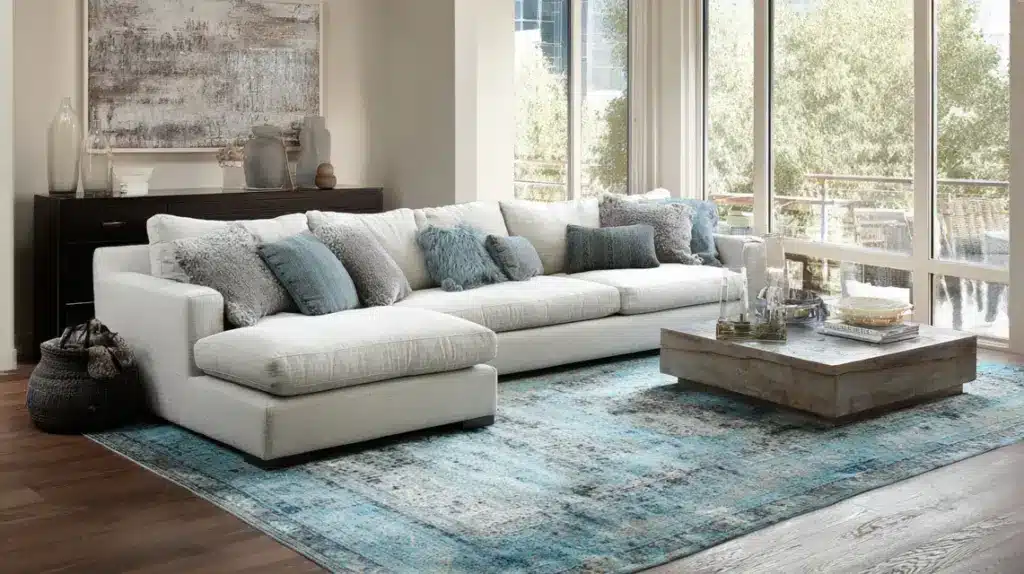
Sectionals and chaise sofas often need larger rugs to feel balanced. Choose at least an 8×10 rug so both main sofa sections have legs anchored on the rug. For larger L- or U-shaped setups, 9×12 or 10×14 rugs are more suitable.
Proper placement defines the lounging zone, avoids awkward floating edges, and makes seating look cohesive. Always measure both sofa arms when planning your project.
5. Open-Concept Layouts: Zoning with Two Rugs
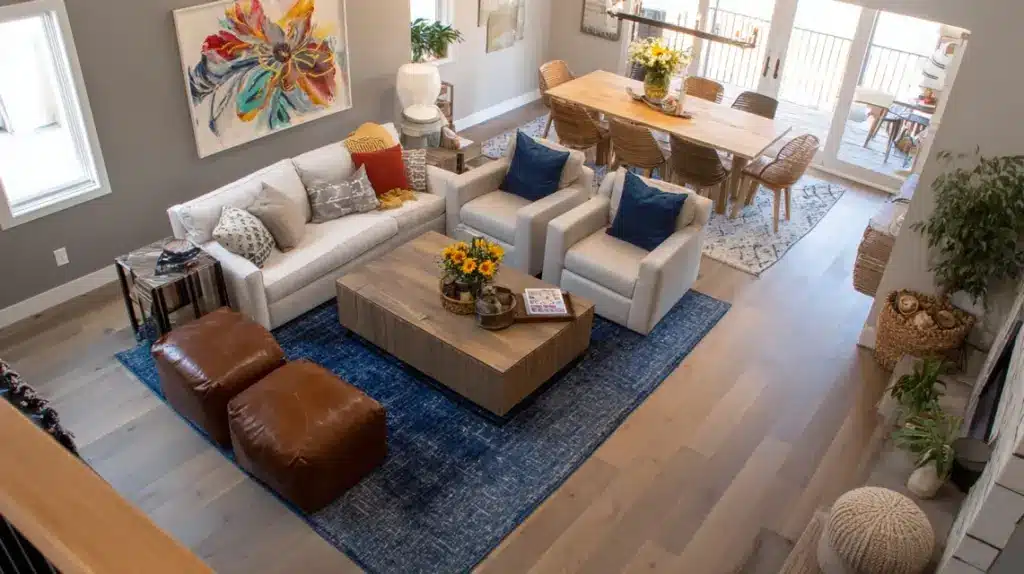
In open-concept living spaces, two rugs help create defined zones. Place a larger rug under the seating area and another under a dining set or workspace. Select rugs that complement each other in terms of size and style, without competing for attention.
Using 8×10 and 5×7 combinations works well. This approach maintains a well-organized layout, prevents furniture from feeling scattered, and provides clear boundaries in large, multi-use rooms.
Bedroom Rug Size Guide
Bedroom rugs should extend beyond bed frames for comfort and proportion. Correct sizing depends on bed type and whether you prefer full or partial coverage.
6. King Bed: 9’x12’ Or 10’x14’
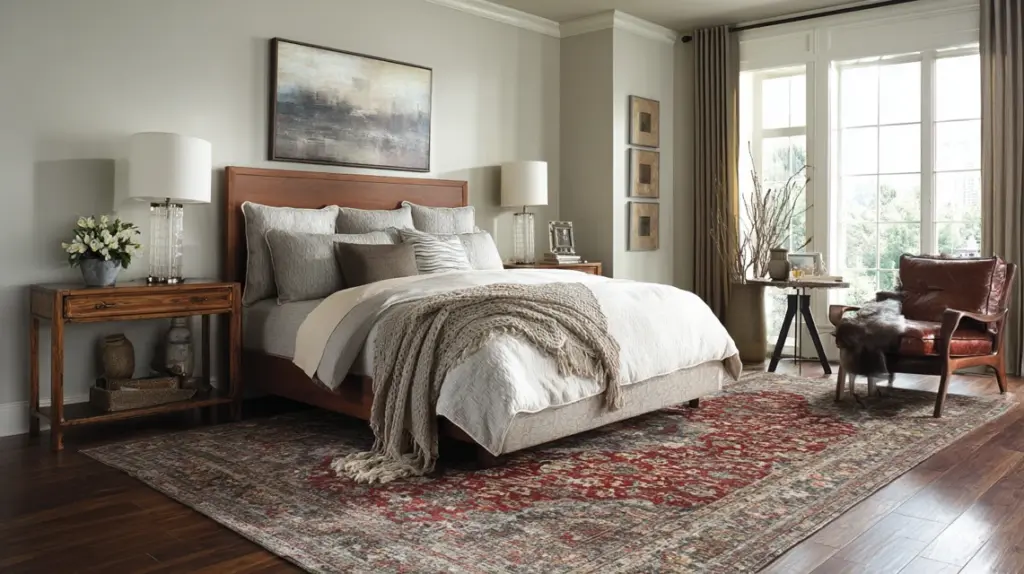
For king beds, rugs sized 9×12 or 10×14 provide ample coverage beneath the frame and nightstands. This setup ensures walking space on both sides. The rug should extend at least 18–24 inches beyond the bed edge for comfort.
Avoid smaller rugs that leave bare areas, as they make rooms appear unfinished. Larger rugs also add warmth and soften acoustics in big bedrooms.
7. Queen Bed: 8’x10’ Or 6’x9’

Queen beds pair well with 8×10 rugs, offering coverage beneath the bed and nightstands. A 6×9 rug works for tighter spaces but leaves less margin. Both options extend walking space, adding comfort underfoot.
The rug should reach two-thirds of the way down the bed if nightstands are excluded. Both sizes extend walking space and add comfort underfoot.
8. Full/Twin Beds: 5’x7’ Or Runners On Sides

Smaller beds work with 5×7 rugs centered beneath the frame or twin runners alongside each side. Runners provide bedside comfort without covering the entire floor.
A single 6×9 rug may also work under a full-size bed, leaving walking space. In compact rooms, this option is practical and affordable. Always align rugs so they don’t obstruct doors or drawers in tight layouts.
9. Nursery/Kids: Play Area Sizing

Nurseries and kids’ rooms benefit from rugs that double as play zones. A 5×7 rug provides a comfortable floor for activities, while an 8×10 works in larger spaces. Runners alongside twin beds add warmth.
Materials should be washable for easy maintenance. Bright patterns help define play zones, while neutral designs keep the room adaptable as kids grow. Always prioritize durability and safety when choosing rug sizes for children’s areas.
10. Layout Styles: Full Bed Coverage, ⅔ Under Bed, Bedside Runners
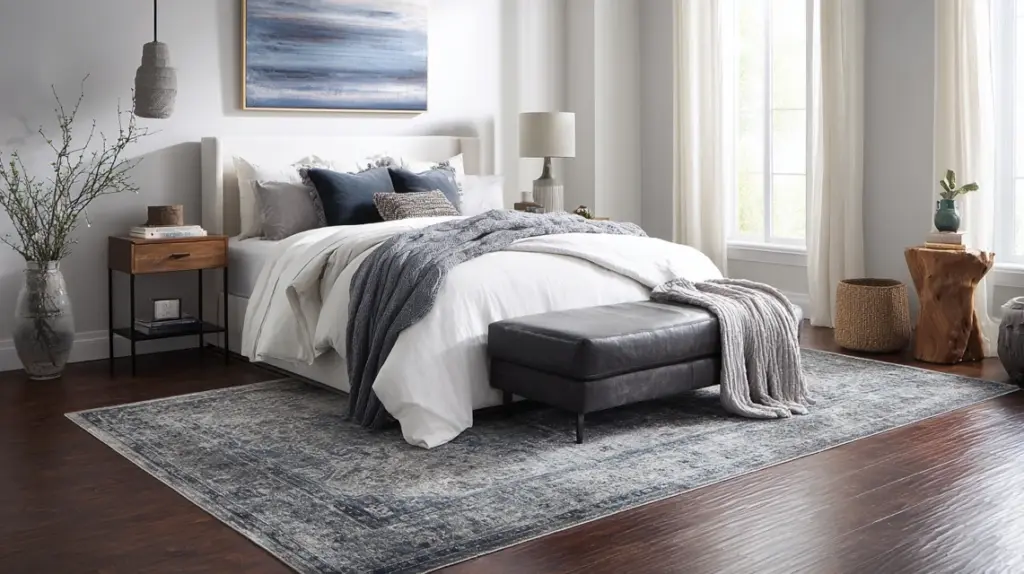
Three main styles exist: full coverage places the entire bed and nightstands on the rug, ⅔ coverage places rugs partially beneath beds, and bedside runners provide narrow comfort strips.
Full coverage requires large rugs like 9×12, while 6×9 or 8×10 works for partial coverage. Runners are flexible, offering affordability and easy replacement. Choose the method that balances comfort, room size, and budget without making the space appear off-scale.
Dining Room Rug Size Guide
Dining room rugs should cover enough area so chairs stay on the rug when pulled out, and so chairs remain on the rug even when pulled back.
11. Four Chairs: 6’x9’ Or 4’–6’ Round

A 6×9 rectangle or a 4–6 foot round rug is ideal for smaller dining tables with four chairs. This ensures enough space for chairs to remain stable when moved. A round rug works especially well with circular tables, creating balanced proportions.
Avoid smaller rugs, as they cause chair legs to wobble off the edge. Always measure the table fully extended if it includes leaves for extra seating.
12. Six Chairs: 8’x10’
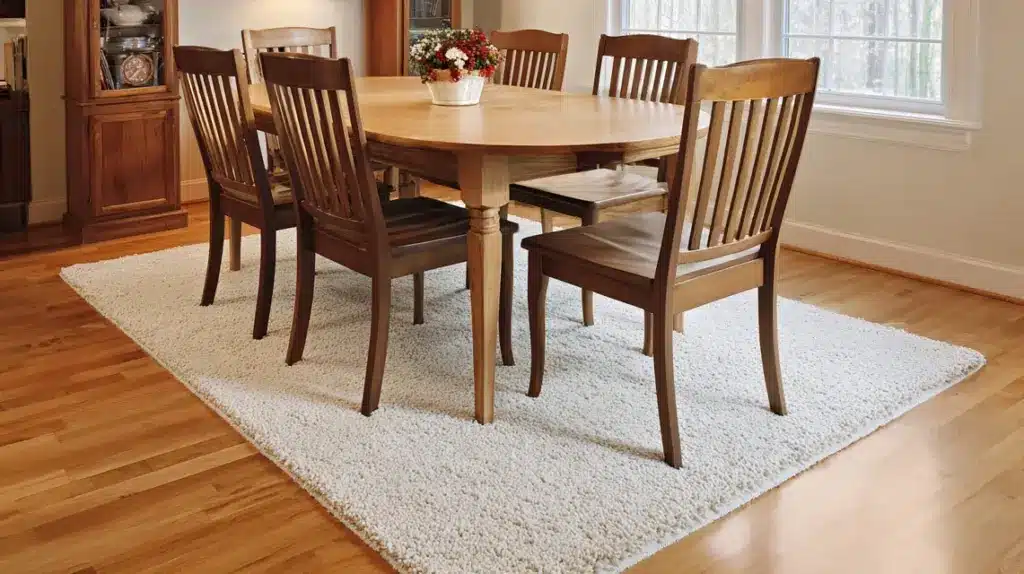
For a six-chair dining setup, an 8×10 rug typically provides ample space. The rug should extend two feet past the table edges on all sides. This coverage allows chairs to remain fully supported while still showing the surrounding flooring.
Rectangular rugs fit most standard tables, though oval tables may also pair well with this size. Choose durable, low-pile materials to handle frequent movement and protect the flooring underneath from scratches or spills.
13. Eight–Ten Chairs: 9’x12’ Or 10’x14’
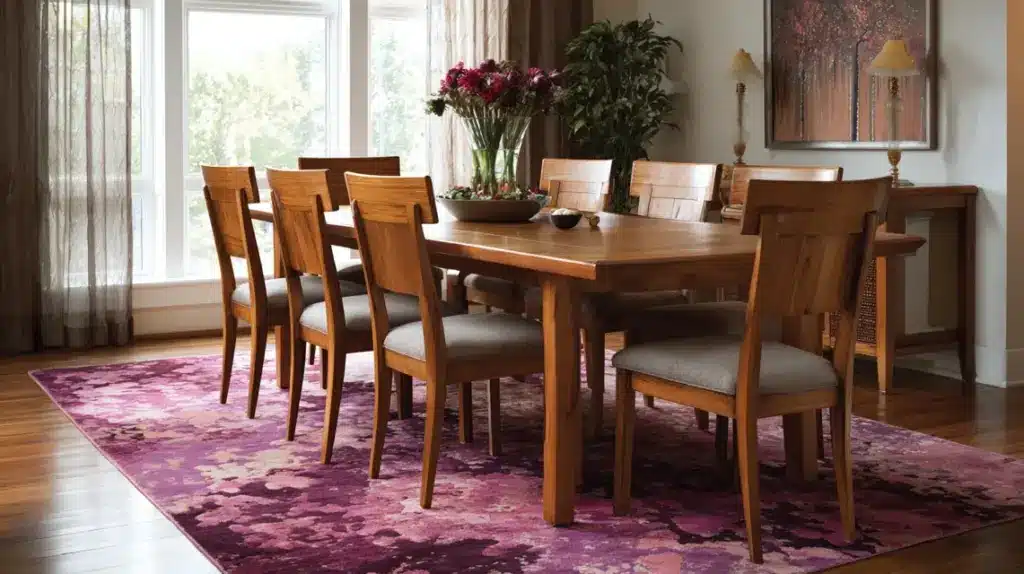
Larger dining sets require bigger rugs, like 9×12 or 10×14. These sizes comfortably handle tables with eight to ten chairs. The rug must extend 24–30 inches beyond the table edges to ensure stability when chairs slide back.
A 10×14 is especially useful for long rectangular tables. With these sizes, dining rooms look balanced and proportional, preventing the awkward look of undersized rugs beneath expansive furniture arrangements.
14. Expandable/Leaf Tables: Size For Largest Configuration

Expandable dining tables demand rugs chosen for the largest extended size, not the smaller collapsed version. When extended, the table and chairs must remain fully supported by the rug. A 9×12 or 10×14 usually accommodates common leaf extensions.
Choosing rugs too small causes chairs to slide off edges, disrupting balance and safety. Planning for the largest configuration ensures flexibility for family gatherings or holiday dinners without needing multiple rugs.
15. Armchair vs. Side Chair Clearance Considerations

Armchairs with larger footprints need extra rug coverage compared to slimmer side chairs. Add at least 30 inches beyond the table edge to accommodate armchairs comfortably. If your dining set includes only side chairs, 24 inches may be sufficient.
Always measure both table and chair dimensions before deciding. This extra clearance ensures comfort, prevents chair legs from catching rug edges, and keeps the dining area balanced during use.
Kitchen
Kitchen rugs need to balance comfort and durability. Sizes vary depending on placement around sinks, stoves, or islands, with materials chosen for easy cleaning.
16. Small Rugs At Sink/Stove
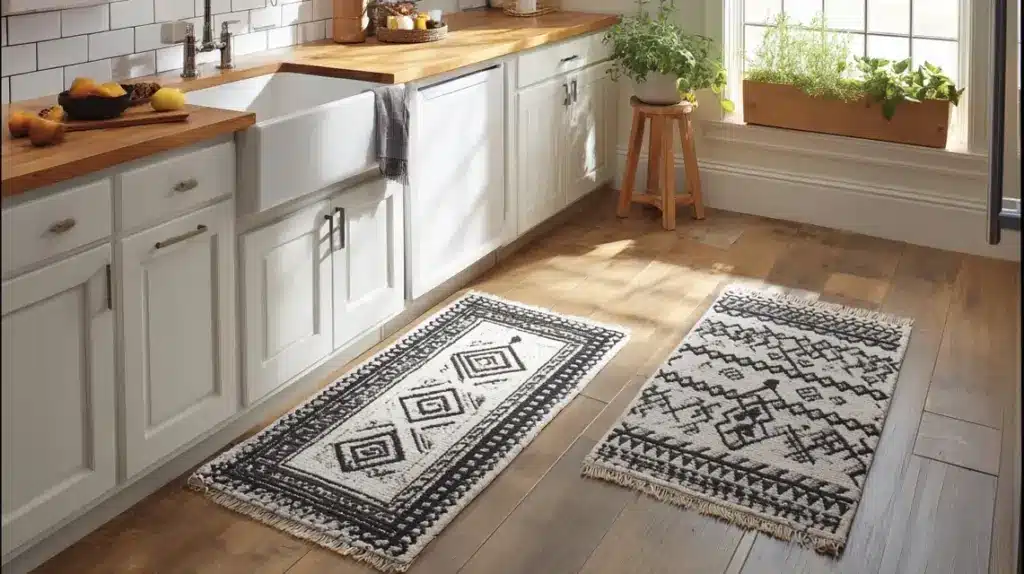
Placing a 2×3 or 3×5 rug at sinks or stoves adds comfort during long periods of standing. These small rugs cushion feet and protect floors from spills. They’re easy to wash or replace, making them ideal for high-traffic zones.
Look for low-pile or machine-washable materials for practicality. These rugs also add warmth and color accents to otherwise plain kitchen floors.
17. Runners For Galley Kitchens
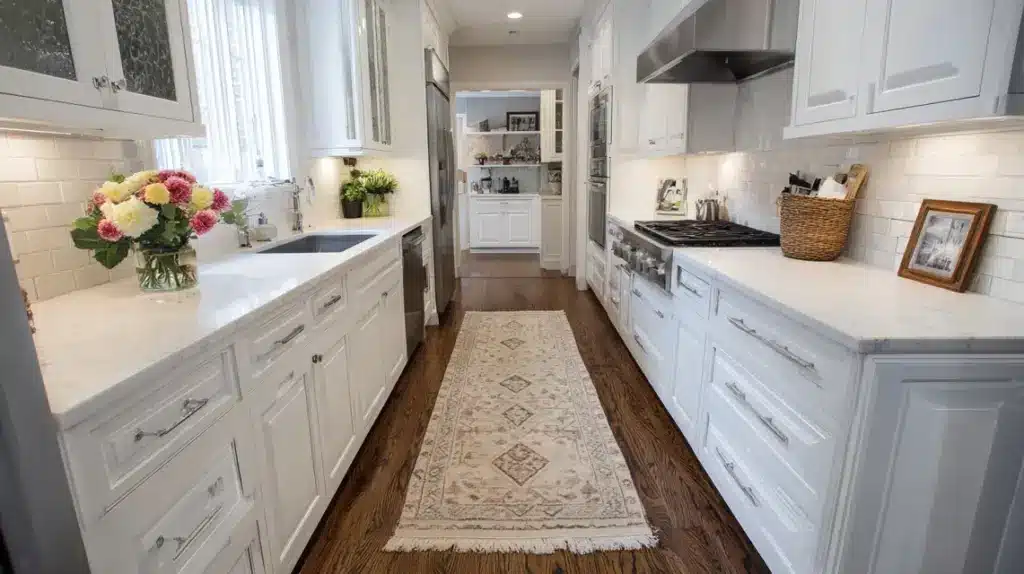
Galley kitchens benefit from long runners, typically 2.5×7 or longer. Runners add comfort along the main walkway and visually lengthen narrow layouts. They protect floors in high-use cooking zones while adding color or texture.
Choose slip-resistant backings for safety on hard surfaces. Washable materials are best, since kitchens are prone to spills. Properly sized runners cover most of the walkway without obstructing cabinets or appliances.
18. Larger Rugs Around Islands
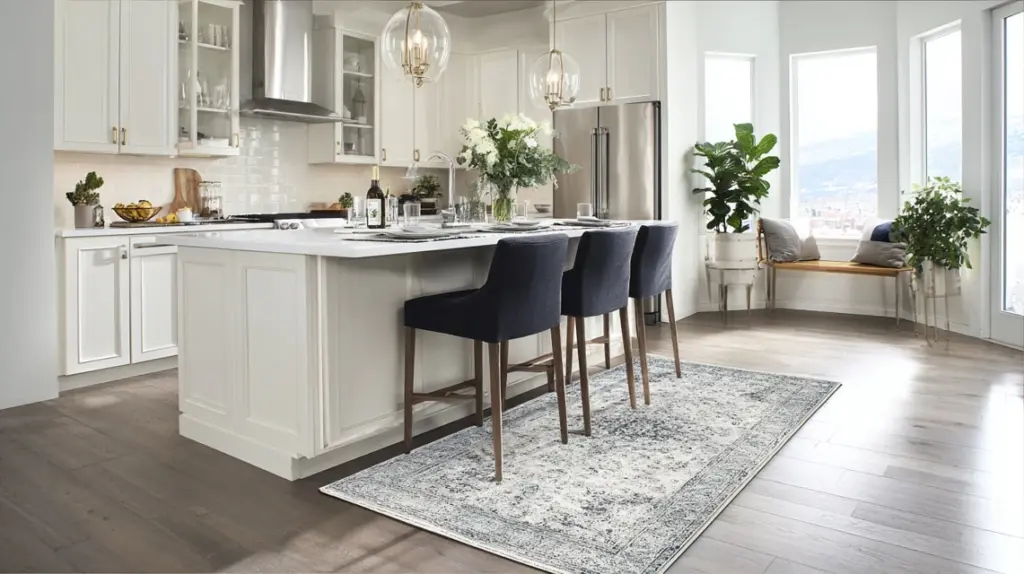
Open kitchens with islands can fit larger rugs, such as 4×6 or 5×7, placed nearby. These rugs define prep or seating areas, adding comfort and style. They soften the space, prevent echoes, and provide protection where stools or chairs slide frequently.
Use durable, stain-resistant materials since food and drink often spill in this zone. Always leave enough clearance for cabinet doors and walkways when placing rugs around islands.
19. Material Considerations: Washable, Cushioned, Spill-Proof

Kitchen rugs must prioritize practicality. Washable rugs are best for frequent cleaning, cushioned mats reduce strain during long-standing sessions, and spill-proof designs protect flooring. Choose materials like polypropylene, PET, or washable cotton blends.
Avoid high-pile rugs, which trap crumbs and moisture. Prioritize rugs with slip-resistant pads for safety on slick kitchen floors. These options provide comfort, function, and easy maintenance in high-use cooking spaces.
Hallways & Entryways
Runners and entry rugs create definition and comfort in narrow or transitional areas. Sizes must align with hallway length or door clearances.
20. Runners Should Cover ~¾ Hallway Length
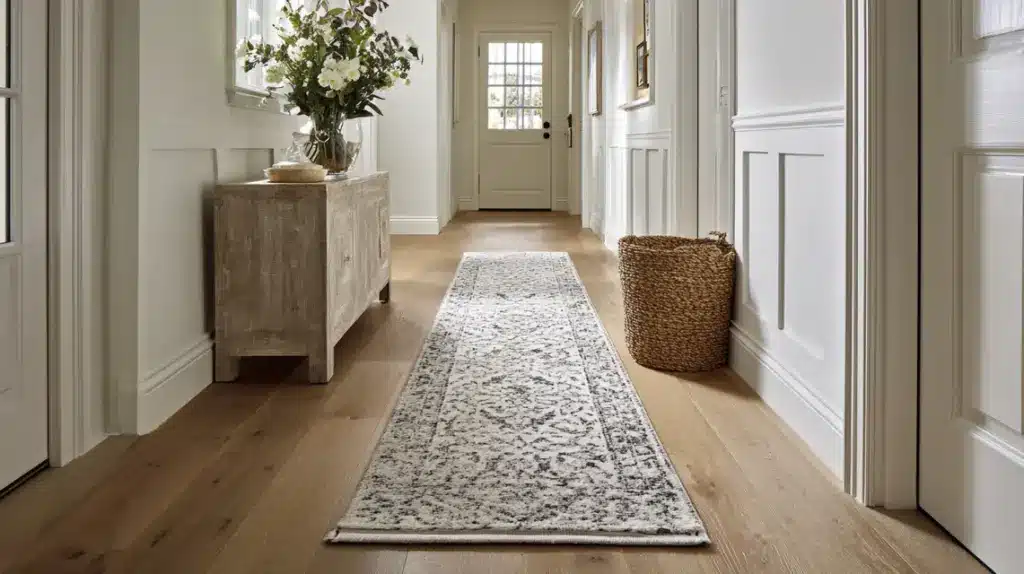
A hallway runner should extend across roughly three-quarters of the hallway, leaving space at both ends. Standard options include 2×8, 2.5×10, and 2.5×12. This creates balance while protecting the flooring.
Keep at least 4–6 inches of floor visible on each side for proportion. Runners add softness, reduce noise, and guide movement naturally through long corridors. Choose low-pile rugs to prevent tripping hazards.
21. Standard Sizes: 2’x8’, 2.5’x10’, 2.5’x12’
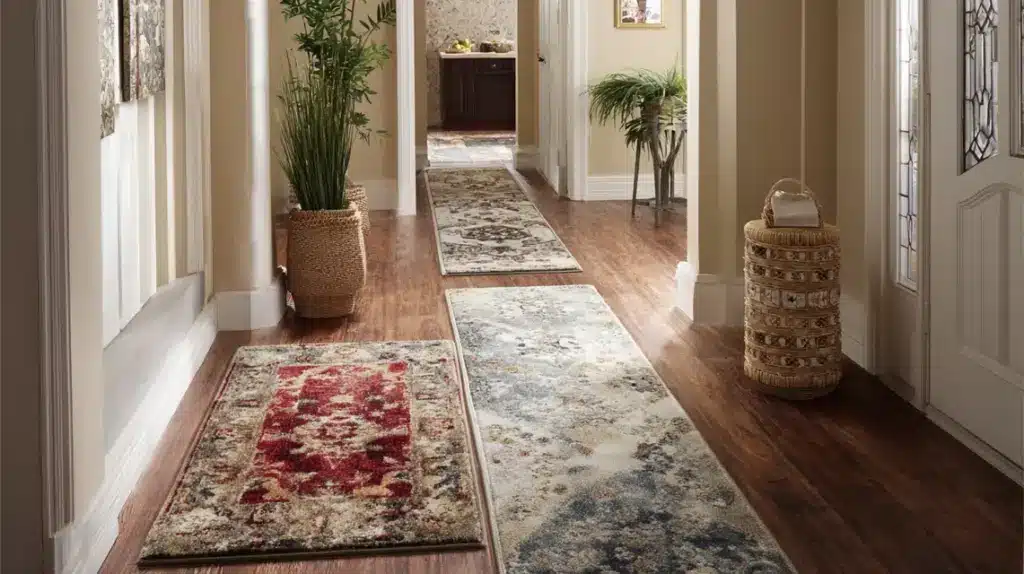
These runner sizes work well in most homes, offering length for various hallway layouts. The choice depends on the exact hallway size, but 2×8 works for compact layouts, while 2.5×12 suits longer hallways.
Always measure carefully before purchasing. Ensure runners don’t bunch at doorways or cover air vents. Adding rug pads improves stability and reduces wear, keeping runners secure even in busy households with heavy foot traffic.
22. Entry Accents: 3’x5’ Or 4’x6’
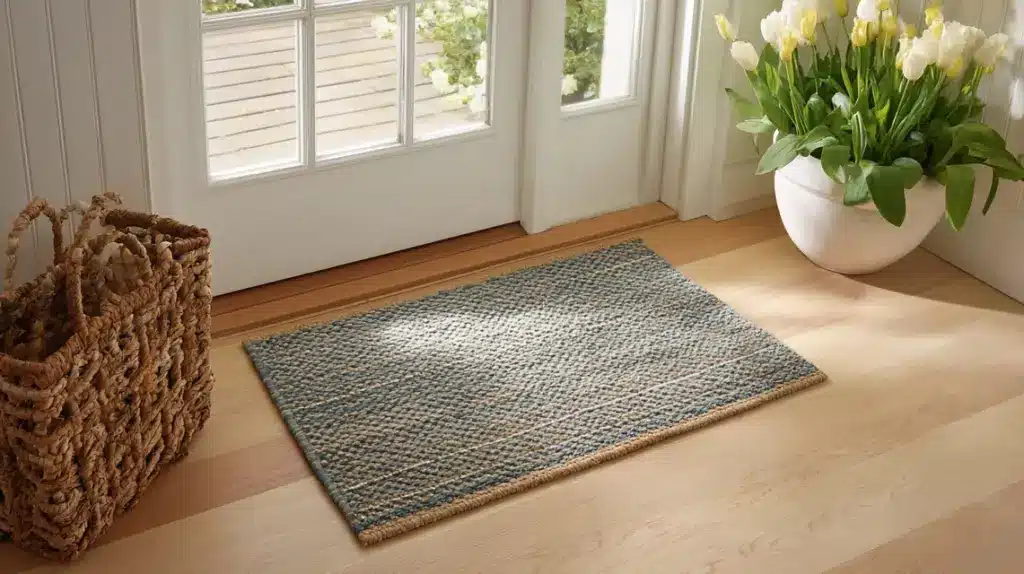
Entry rugs set the tone for the home. A 3×5 rug fits most small foyers, while a 4×6 covers larger spaces. These rugs should clear door swings fully and leave floor space visible around edges.
Materials should handle heavy dirt and moisture, making washable or indoor/outdoor rugs ideal. Entry rugs also provide safety by preventing slips, while offering a welcoming design statement as soon as guests arrive.
Outdoor Spaces
Outdoor rugs define seating, dining, or lounging zones on patios and decks. Choose durable, weather-safe options sized to furniture layouts.
23. Small Patios/Entryways: 2’x3’ Or 3’x5’
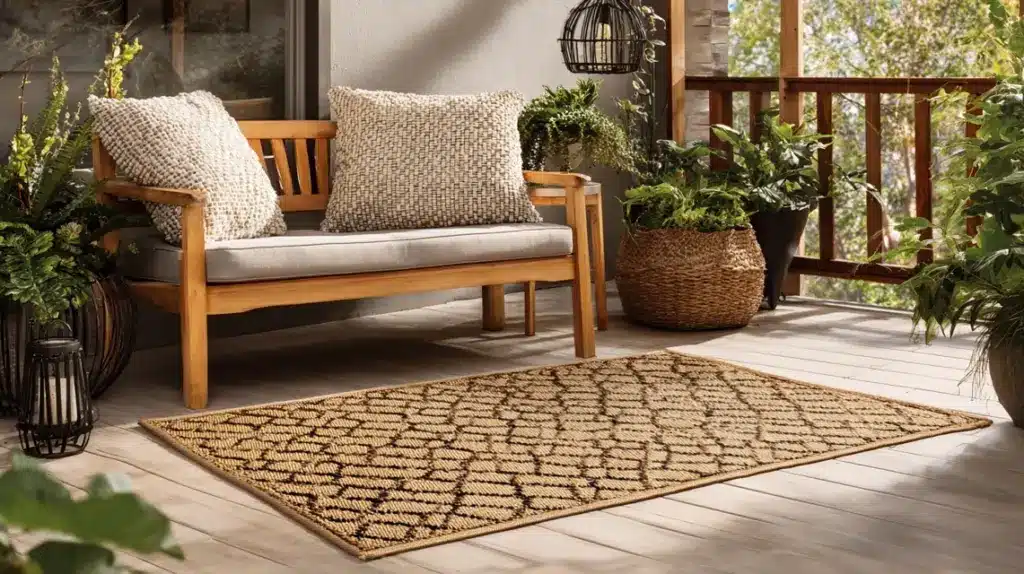
Small outdoor rugs like 2×3 or 3×5 fit tight entry spaces or compact patios. They provide comfort while adding a defined surface for shoes or small seating areas.
Choose weather-resistant materials like polypropylene that dry quickly and resist mildew. These rugs enhance function without overwhelming a limited space. Always secure them with outdoor pads or furniture to prevent shifting in windy conditions.
24. Medium Decks: 5’x7’ Or 6’x9’
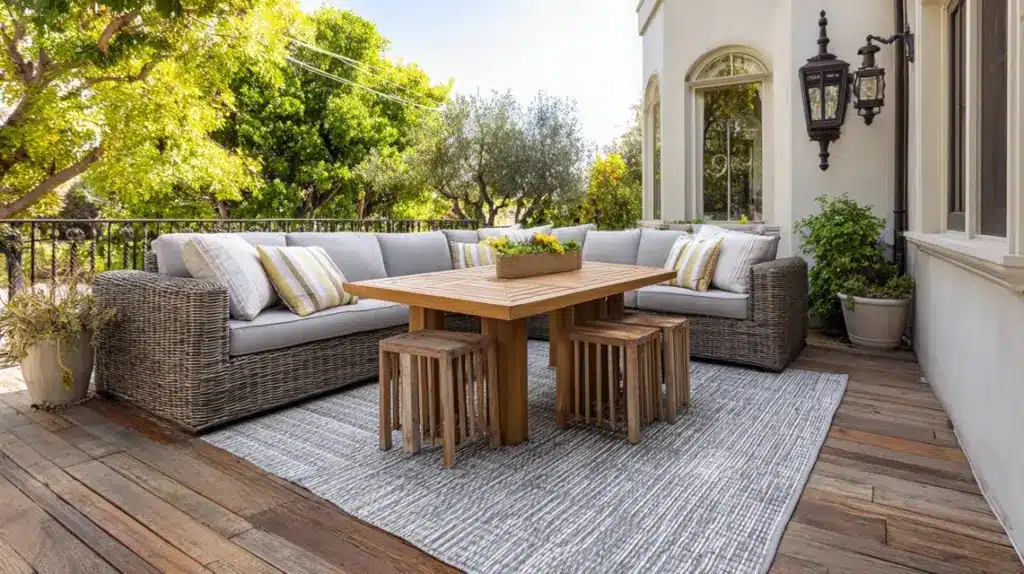
For medium patios or decks, 5×7 or 6×9 rugs offer ample coverage beneath smaller dining tables or sectional sets. They help define outdoor living areas while adding softness to the underfoot experience.
Look for fade-resistant, quick-dry materials that can withstand sun and rain. Properly sized rugs unify seating zones, making decks more inviting. Avoid rugs that are too small, which can make outdoor furniture appear awkwardly arranged or unbalanced.
25. Large Dining/Seating Sets: 8’x10’ Or 9’x12’
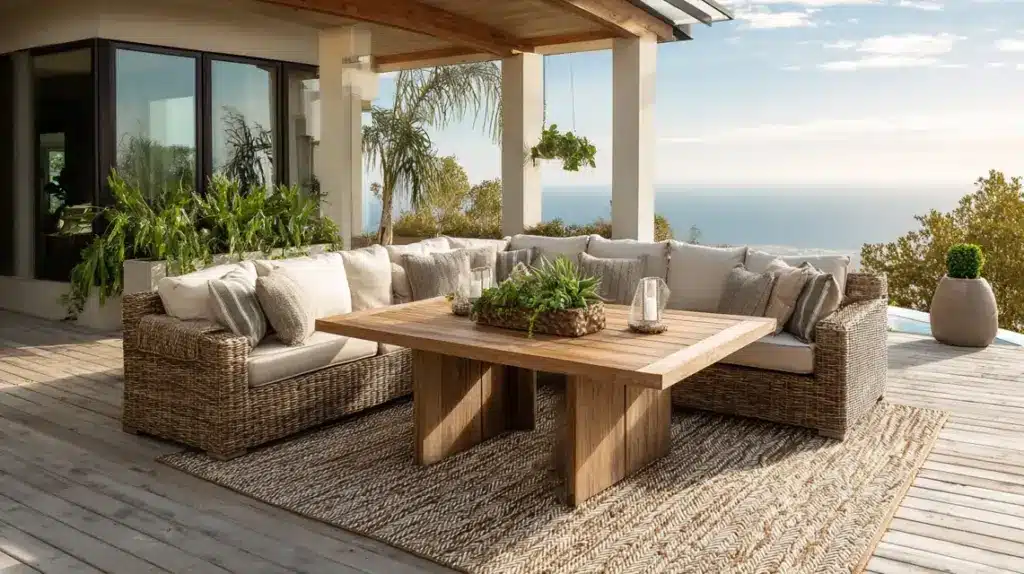
Big outdoor spaces benefit from oversized rugs like 8×10 or 9×12. These rugs anchor dining tables with six to eight chairs or large sectional seating. They reduce echo on hard decks, provide comfort, and visually unify open layouts.
Weather-safe construction is critical; opt for polypropylene or PET materials. Securing rugs with heavy furniture or anchors prevents shifting. A properly sized outdoor rug creates cohesion and comfort in expansive entertainment areas.
26. Weather/Safety: Anchoring, Drying

Outdoor rugs face unique challenges. Anchoring with furniture prevents shifting in wind, while choosing quick-drying materials avoids mildew. Place rugs in shaded areas to reduce sun fading.
Washable outdoor rugs make cleaning easier, especially in high-traffic zones. Use outdoor pads to prevent slipping on smooth decks. Rotate rugs seasonally for even wear. These strategies extend rug life and ensure outdoor spaces remain functional, safe, and visually appealing year-round.
Rug Shapes and Special Formats
Different rug shapes suit specific layouts. Choose round for circular tables, square for symmetry, oversized for open rooms, and layering for creative dimension.
| Rug Shape / Format | Best Use Cases | Typical Sizes | Key Placement Tips |
|---|---|---|---|
| Round Rugs | Circular dining tables, nurseries, playful seating zones | 4’, 6’, 8’, 10’ diameter | Center under round furniture; leave even floor border |
| Square Rugs | Square rooms, symmetrical layouts, balanced dining areas | 6’x6’, 8’x8’, 10’x10’ | Align rug edges with walls or furniture lines |
| Oversized Rugs | Open-concept spaces, large living rooms, loft layouts | 12’x15’, 12’x18’ | Use to unify multiple zones; cover wide seating areas |
| Layering Combos | Adding texture, framing accents, and defining focal areas | 9’x12’ base + 6’x9’ topper | Place a smaller rug centered on a larger neutral rug |
Safety, Comfort, and Everyday Function
Rugs should look good, but they also need to perform safely and comfortably. Start with a proper rug pad matched to your flooring type, such as hardwood, vinyl, tile, or carpet, for added grip and protection.
Always check door clearance, since a thick pile can block swing space. Keep walkways at least 36 inches wide and secure rug edges to prevent tripping, especially for seniors or children.
In open layouts, remember that larger rugs not only tie spaces together but also help reduce echo, making rooms feel calmer and more comfortable.
Common Mistakes to Avoid
Choosing the wrong rug size or setup is easy. Avoid these frequent mistakes to keep rooms balanced and practical.
- Choosing rugs that are too small: Undersized rugs leave furniture floating and make the space feel unbalanced.
- Centering rugs only under tables: Rugs should support the entire furniture setup, not just the table alone
- Ignoring manufacturer size variations: A “6×9” might measure smaller; always confirm exact dimensions before purchase.
- Skipping rug pads: Always use one for grip and floor protection.
By steering clear of these common pitfalls, you’ll ensure your rug improves the room’s flow and functionality.
Take the time to measure carefully, consider your furniture layout, and invest in quality accessories like rug pads; your space will look polished and feel complete.
Conclusion
Now that you’ve found standard rug sizes, you can approach every room with confidence. You’ve seen how different dimensions work for living rooms, bedrooms, dining areas, and even outdoor spaces.
You’ve also picked up formulas, layout ideas, and a handy chart to make measuring easier. Think about your own home.
Is your rug helping the room feel balanced, or is it time for a change? The right rug size doesn’t just add comfort; it ties everything together.
Keep these tips handy and check out my other posts for more simple ways to make your home feel complete.














